Monogram 1/48 A6M5 Zero
The Monogram A6M5 Zero is a very simple model. It has no real cockpit detail, a one piece canopy, and you can see through it looking from below through the wheel wells, when the landing gear is down. But when I was 14 years old, I won my first local hobby shop modeling contest with this kit, so it has a special place in my heart (In 1978, a $25.00 gift certificate went a long way). Also, because the kit is by and large not very expensive, I have used many of them as guinea pigs over the years to hone my modeling skills.
In the Beginning
Opening the box on this kit, you will not find a whole lot. This is a recent reissue, shot in overall light grey plastic. Even the previously released versions that had the black propeller, cockpit parts (what little there are), and wheel struts are, this time around, all in one uniform light grey color. There is some flash, but mainly on the larger wing parts, which are easily removed without too much effort. There are casting seam marks on the wheel struts, but overall, there is not a lot of molding cleanup. Not too bad for a model that came out in 1962.
Construction
Usually, aircraft construction begins with the cockpit. But because there is really no cockpit detail at all, only molded in side walls, rudimentary instrument panel, and a pilot figure, which has the seat attached to him, there is not really too much to do. I painted the interior cockpit area Pollyscale Soviet Green, in an attempt to copy the Bamboo Green color that is, at least for now, the latest color shade in interior Japanese aircraft among the modeling community. I did not include the hybrid pilot/seat. I also painted the area in front of the cockpit area that could be viewed from the ground up through the wheel well area. This was painted Gunze's Metallic Blue, which, is also the current “it” color for WWII Japanese aircraft wheel wells.
I then glued the two fuselage halves together. While all this paint was drying, I proceeded to construct the sub-assemblies. The wings are actually three pieces, a large lower one piece, with left and right half upper pieces. Be careful with this step, as the two 20 MM wings cannons, as well as the pitot tube have to be glued in first. Before wing assembly, I again painted the interior wheel wells Gunze Metallic Blue, as well as the interior side of the landing gear doors. In addition to the cannons and pitot tube, this model has the “working landing gear”, meaning that you can open and close the landing gear when you were playing with this kit. Because of this, you have to put the landing gear struts in the lower wing assembly in the down position. Then you attach the two upper wing halves to the lower wing, and this keeps the struts from falling out. While the wing assembly was setting, I put the stabilizers on the main fuselage, and let everything set for the night.
After everything described above had set, I glued the fuselage to the wing assembly, which fit pretty good. The top side looked fine, with minimal filling, but the underside need some work, particularly where the back end of the lower wing assembly and the bottom part of the fuselage meet. In addition to filling and sanding, I got the main wheels ready, as well the evil painting of the canopy lines, since I already knew that I was going to be painting the aircraft IJN Green over IJN grey. After this was done, and everything was to my liking, the painting began.
Painting
Painting this aircraft was relatively easy. I laid down the underside first with Pollyscale IJN Grey, and then I did the upper surface Pollyscale IJN Green. As usual, I employed the qtip method of painting that I have developed, and it worked out really good for the demarcation line, especially on the rear quarter fuselage. After a little touch up here and there, I sprayed on a coat of glosscote from the can for the decal stage.
Decaling and Weathering
After my decal experience with the Kingfisher model I did a while back, I went with the kit decals again, and they worked out very good. I wanted to do an early A6M5 that had been stationed at Rabaul, but I needed a number that was done in a somewhat gothic style font, as opposed to the yellow symbol that came with the decal sheet. This number was on the rudder of the aircraft I wanted to do.
After looking in the parts box, I found such a number on one of the decal sheets for the excellent Tamiya 1/48 scale tanks that I am also building (This particular sheet is from the Stug IIIB). After all the decals had been put on, I used the Microsol on the larger decals, and Microset on the smaller ones. After these had dried, I sprayed another layer of glosscote. After letting the glosscote dry for a day, I did some weathering. I did not go overboard on the weathering. Even though I know that Japanese paint did not seem to hold up very well, I still feel that finished models of Japanese planes seem so over weathered when they show the paint peeling all over the aircraft. I did some peeling paint, mainly near the leading edges, and I lightened up the top fuselage, but like I said, I did not go overboard.
Final Assembly
After the final painting, decaling, and weathering was done, a last swipe of Dullcoat was done to seal everything in. After this, the one piece canopy was glued on with Krystal Kleer. The antenna wire was then installed, and the landing strut oleos were painted bright silver.
Conclusions
Although not an award winner by any means, I like the Monogram Zero, mainly for its ease of assembly, which is great for beginners who are getting their feet wet. Although considered crude by todays modeling community, it has a place in my heart. After all, I did win a contest with one!
Until next time…
Copyright Kipling Mitchell © All Rights Reserved.
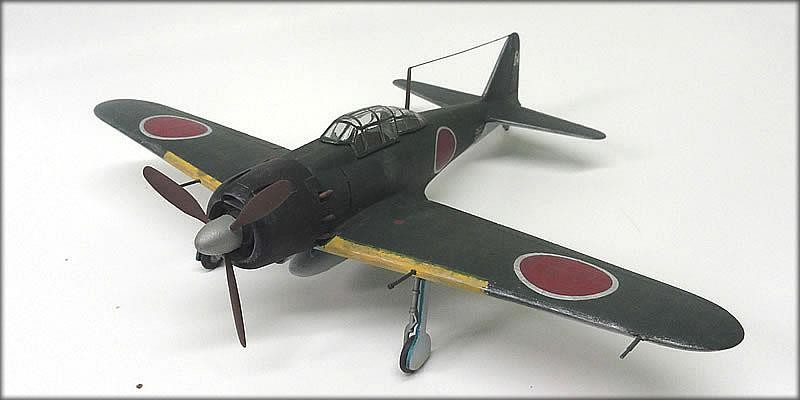
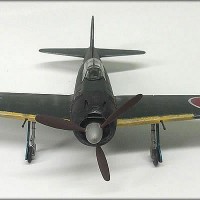
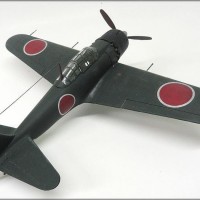
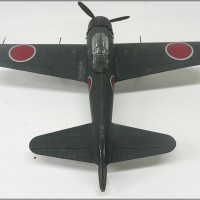
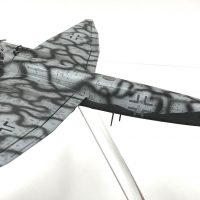

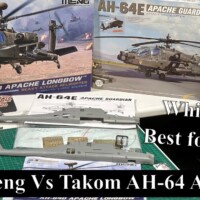

Well done example of the "Zeke", sir.
Nice! Got to love those 1/48 Monograms.
Ah yes I shot many of these down in flames with my Monogram P-40B "Tiger Shark" back in the day. Still looks like a Reisen. Monogram deserves a place for being the first "real" model company.
Thank you for a very refreshing build report.
I'm so tired of these long lists with aftermarket parts and special weathering products. Good modelling is about using basic building and painting techniques to good effect, which is exactly what you have done here.
Tora Tora Tora
I'm with Ulf on this one, I really enjoyed reading your build article. Please can you explain your "Q tips method"?
Good Morning ,
The one area that I really do different from a lot of people who make models today is the painting phase. I never got the hang of using an airbrush, so I had to devise another method to hide both brush strokes and to make a soft edge demarcation line between the upper and lower color schemes that most US military aircraft used in World War II. The technique I came up with was to paint my aircraft using acrylic paints, an old fashioned paint brush, and a somewhat unique tool, the Qtip.
In general, acrylic paints are very good at hiding brush strokes, not to mention they are water based, and are easy to clean. The issue is the actual paint brush itself. In general, I use the old Testors white plastic handle paint brushes that you can get just about anywhere that sells model kits. For large areas, I use the Testors 3/8 inch wide paint brush. After laying down the first coat of paint with a paint brush, I use the Qtip for the second coat. I use the Qtip kind of like a paint roller. I dip the Qtip into the paint, then I gently roll the paint dipped end onto a piece of paper to get rid of any excess paint. I then roll it on to the surface, just like a paint roller. The real big issues with this method are that you could get fibers in your paint (and on your model), you will go through quite a few Qtips, and your fingers will get cramped after a while. But if you like to brush paint like me, or you just can’t get the hang of airbrushing, then give the Qtip a try!
The other reason I love the Qtip is for the soft edge demarcation lines. Again, as described above, dip the Qtip into some paint, but this time roll and tap it up and down onto some paper until it is almost dry. Then pick the area on your model that will have the soft edge, and tap it vertically up and down rapidly using the tip of the Qtip, while moving the Qtip along the area that you want the soft edge line to be horizontally. You are in effect dry brushing a line. Because the Qtip is soft, you will see a soft edge line become visible. Now this does take some practice, especially on the amount of paint you should have on the Qtip, so use an older model or some test kit that you really do not care about to much before doing this. But once you get comfortable with it, you will be surprised how good it will come out.
Thanks for that info, I'll have to give it a try.
I built that kit when it first came out, circa 1965, it was the best zero available at the time, painted it with the old Pactra paints, at the time I thought it looked pretty good, but I was 13.
Nice zero. I also prefer to do more scratchbuilding than defaulting to aftermarket stuff - it also keeps the expense down!
Kipling, thanks for the (Q) tip. I was in my favorite hobby shop today, and some Japanese outfit (think it's the "Mr" everything folks- Mr. Glue, Mr. Putty, ad infinitum) Can't you see Sidney Poitier- as in Heat of the Night, saying "THEY call me MR. Dissolved Putty!" They are selling packets of Q-tips(!) with various shaped ends, pointed, round. Not as cheap as the generic ear cleaning ones, mind you. Looked interesting, albeit expensive.
If I get curious enough, I'll report further.
I always liked the old Tamiya and Fujimi Zeroes for the early ones. I "know" the Hasegawa is better, but I'm prejudiced.